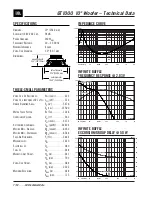
Rythmik Audio L12/L22 Amplifier Quick Guide
*More information can be found at
www.rythmikaudio.com/phase1.html
Volume level setting
is determined by
the efficiency of front speakers. It is not
an indication of whether the sub can
play louder or not.
Crossover setting
is a fine-tuning knob for integration. It is useful even when
one already uses bass management. The upper end extension of the sub is
limited to avoid using the servo subwoofer at frequencies where servo is less
effective. Set to max by default.
LPF slope setting
determines the slope of crossover setting. For
two-channel
,
one should use 24db whereas for HT input, one should use 12db.
*Delay/phase control
One of the most important controls
for integration without external
delay time adjustment control. See
our integration guide*.
Power LED indicator
The power switch has 3 positions:
OFF, AUTO, and ON. AUTO detects
the input signal and turns on the amp
immediately and turns off the amp
after 45 minutes of inactivity.
Bass extension switch
This switch determines the bass extension as well as the rumble
filter. Low music setting has the lowest extension with high
damping. Low-HT incorporates a 3
rd
order rumble filter at 20hz to
make it more suitable for HT application. High extension setting
uses a single 3
rd
order HPF with a cut off frequency around 28hz
for those who would like to have higher SPL output while still
maintain good group delay characteristics.
Line Level inputs
For sub output from HT
receiver/processor,
one
can use either of the two
(R+L) line level inputs with
12db LPF SLOPE switch
setting, or just LFE IN.
When using LFE IN, phase
control
and
crossover
control have no function.
The
trade-off
between
using LFE IN and LINE IN
is
the
perceived
background noise level.
For
two-channel
inputs,
one should use LINE IN
only.



















